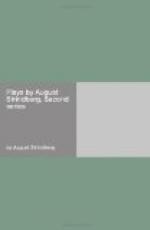Mr. Hansson has printed a number of letters (Tilskueren, Copenhagen, July, 1912) written to him by Strindberg about that time, as well as some very informative comments of his own. Concerning the performance of Malmoe he writes: “It gave me a very unpleasant sensation. What did it mean? Why had Strindberg turned my simple theme upsidedown so that it became unrecognisable? Not a vestige of the ‘theme from Ola Hansson’ remained. Yet he had even suggested that he and I act the play together, I not knowing that it was to be a duel between two criminals. And he had at first planned to call it ’Aryan and Pariah’—which meant, of course, that the strong Aryan, Strindberg, was to crush the weak Pariah, Hansson, coram populo.”
In regard to his own story Mr. Hansson informs us that it dealt with “a man who commits a forgery and then tells about it, doing both in a sort of somnambulistic state whereby everything is left vague and undefined.” At that moment “Raskolnikov” was in the air, so to speak. And without wanting in any way to suggest imitation, I feel sure that the groundnote of the story was distinctly Dostoievskian. Strindberg himself had been reading Nietzsche and was—largely under the pressure of a reaction against the popular disapproval of his anti-feministic attitude—being driven more and more into a superman philosophy which reached its climax in the two novels “Chandalah” (1889) and “At the Edge of the Sea” (1890). The Nietzschean note is unmistakable in the two plays contained in the present volume.
But these plays are strongly colored by something else—by something that is neither Hansson-Dostoievski nor Strindberg-Nietzsche. The solution of the problem is found in the letters published by Mr. Hansson. These show that while Strindberg was still planning “Creditors,” and before he had begun “Pariah,” he had borrowed from Hansson a volume of tales by Edgar Allan Poe. It was his first acquaintance with the work of Poe, though not with American literature—for among his first printed work was a series of translations from American humourists; and not long ago a Swedish critic (Gunnar Castren in Samtiden, Christiania, June, 1912) wrote of Strindberg’s literary beginnings that “he had learned much from Swedish literature, but probably more from Mark Twain and Dickens.”
The impression Poe made on Strindberg was overwhelming. He returns to it in one letter after another. Everything that suits his mood of the moment is “Poesque” or “E. P-esque.” The story that seems to have made the deepest impression of all was “The Gold Bug,” though his thought seems to have distilled more useful material out of certain other stories illustrating Poe’s theories about mental suggestion. Under the direct influence of these theories, Strindberg, according to his own statements to Hansson, wrote the powerful one-act play “Simoom,” and made Gustav in “Creditors” actually call forth the latent epileptic tendencies in Adolph. And on the same authority we must trace the method of: psychological detection practised by Mr. X. in “Pariah” directly to “The Gold Bug.”




